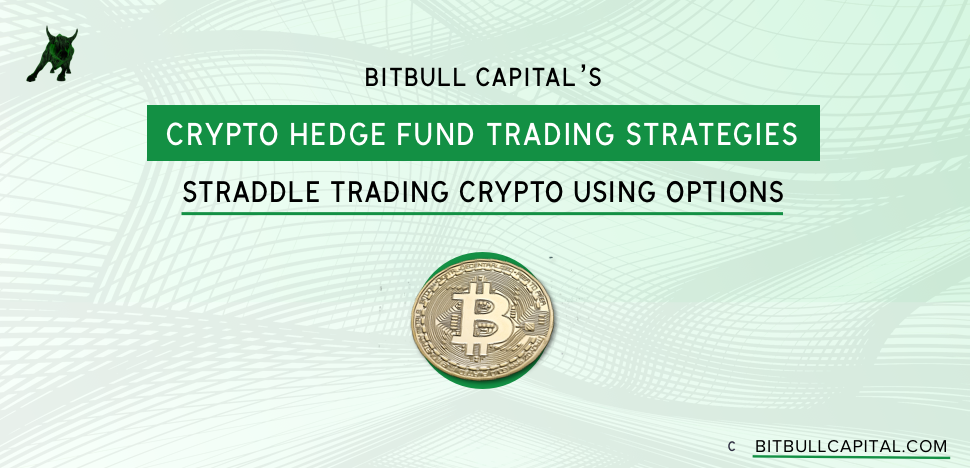In the previous article for our “Crypto Hedge Fund Trading Strategies” series, we discussed market making as one of the strategies which work regardless of market direction. Today we are going to touch upon another market neutral strategy called the Straddle, which is done using options.
From our two funds – the first crypto fund of funds, and a direct, opportunistic fund – BitBull Capital has done diligence on hundreds of the 600+ crypto funds and their many strategies. BitBull Opportunistic then leverages the diligence we do with our Fund of Funds, where we focus on what strategies we see performing best in present market conditions. Learn more about our funds here.
A Brief Look at Options Trading
Before we can discuss straddle trading, it is useful to understand options. Based on underlying instruments (stocks or cryptocurrencies for instance), options are derivatives which, like future contracts, give buyers the ‘option’ to buy or sell the underlying asset.
However, unlike futures contracts, options do not place an obligation on the buyer (which is why they are called options). The key terms in options trading include ‘call’, ‘put’, ‘strike price’, ‘expiration’ and ‘premium’.
- Call: An option whose holder can buy the underlying asset at a specified price within a specified time period
- Put: An option whose holder can sell the underlying asset at a specified price within a specified time period
- Strike Price: The specified price at which an option has to be executed, whether it is a call or a put
- Expiration: The time period before which an option has to be executed, whether it is a call or a put
- Premium: This is the cost of buying an option and is charged separately from what the option’s execution may incur
Value of Put and Call Options
Put and call options become more or less valuable based on the underlying instrument’s price action.
For example, if you bought a put option (option to sell) for Bitcoin at $9,000, your option would become more valuable if Bitcoin trades below $9,000.
Similarly, if you bought a call option (option to buy) for Bitcoin at a strike price of $9,000, your option would become more valuable if Bitcoin trades above $9,000.
However, it is important to factor in the premium paid for an option on top of the strike price to be paid, in order to calculate the net profitability.
If your call option for Bitcoin at a strike price of $9,000 cost you $50 in premium, you will only profit if Bitcoin trades above $9,050. However, if you decide not to exercise the option in the event that the price falls or remains the same, you will walk away with a loss of $50 paid as premium.
How Crypto Straddle Trading Works
Straddle trading is a strategy which plays both sides of an option contract in a bid to profit from any move, up or down, in the underlying asset’s price.
Let’s continue with the example mentioned above to explain straddle trading.
Instead of buying only a call or a put option for Bitcoin at a strike price of $9,000 and a premium of $50, we can decide to buy both options – a call and a put.
The purchase of both these options will cost us $100 ($50 + $50) in premiums and we will consequently have the option to either buy or sell at a strike price of $9,000.
Now, if Bitcoin price rises and goes up to $9,050, our call option is worth $50 more, but when we add our premium cost of $50 to it, we break even. However, we are losing $50 on our put option (because we agreed to sell at $9,000) and even if we don’t exercise it, our $50 premium is lost.
So in the scenario above, we lose money because Bitcoin (the underlying asset) did not move beyond the range established by the premium paid for options (+/- $50).
For a straddle trade to be profitable, the price of the underlying security needs to fall outside this range.
Continuing this example, if Bitcoin’s price, instead of rising to $9,050 dropped to $8,000, here’s how our straddle trade would play out:
Our call option would be worth zero and we would lose our $50 premium on it. Our put option, however, would be worth $1,000 more, minus the $50 premium. Ultimately, we would have a profit of $1,000 – ($50 + $50) = $900.
In our final example, we assume that Bitcoin’s price rises to $9,500. Here, our call option would be worth $500 minus the $50 premium while our put option would be worth zero and we would lose our $50 premium on it. In the end we would have a profit of $500 – ($50 + $50) = $400.
Risks Associated with Straddle Trading
As shown in the example above, straddle trading works great as long as the underlying instrument’s price moves considerably beyond the range set by the premium you pay around the strike price.
This means if the price does not deviate beyond this range, we stand to lose premiums on both our options. Hence, the risk associated with straddle trading materializes if the underlying instrument does not move enough, or at all, in terms of price.
However, with volatile instruments such as Bitcoin, straddle trading provides numerous potential opportunities for profit, making it an effective market neutral strategy for crypto funds like ours. You can read about all the other crypto trading strategies we employ here.
—

